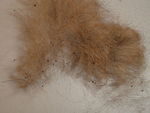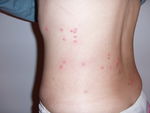Difference between revisions of "Flea Habitat and Control"
| Line 35: | Line 35: | ||
*For more information on the chemicals used for flea treatment click | *For more information on the chemicals used for flea treatment click | ||
[[Ectoparasiticides|here]] | [[Ectoparasiticides|here]] | ||
| − | [[Category:Fleas]] | + | [[Category:Fleas|C]] |
[[Category:To_Do_-_Parasites]] | [[Category:To_Do_-_Parasites]] | ||
[[Category:To_Do_-_NickJ]] | [[Category:To_Do_-_NickJ]] | ||
Revision as of 11:02, 27 July 2010
| This article is still under construction. |
Habitats
Although adult fleas are obligate blood feeders only 5% of the flea population will be on an animal at any one time. The remaining population inhabits the surrounding environment, though they are never far from a potential host species. The population that is not on the host consists of eggs, larvae, pupae and unfed adults. In the environment the adult fleas as well as the other stages are found in 'hot spots' where a potential host animal spends most of its time. These areas are usually warm, shady and humid and therefore usually indoors in regions with a cooler climate. It is common to find large numbers of eggs in areas where cats land after jumping as this dislodges the eggs from the hair.
Control
Control of flea infestations does not involve only the affected animal as the majority of the population is fee living in the environment. A single treatment or occasional treatment of the animal will provide temporary relief but will not control the issue. In order to properly control the several stages must be followed in order to remove the initial infestation and prevent re-infestation.
- Single or occasional treatments will only give temporary relief from fleas as the majority of the population is in the environment
- Appropriate action must be taken to stop re-infestation
- The animal must be rid of its resident flea population
- The animal should be protected against subsequent re-infestation
- From within the home
- From outside the home
- The environmental reservoir population should be eliminated
- Animal treatment to deplete reservoir
- Adulticides
- Adulticides with larvicidal effects
- Insect growth regulators (IGR's)
- Direct chemical treatment of domestic environment
- Insecticides
- Insect growth regulators
- Inorganic chemicals
- Entomophagous nematodes (These are parasitic nematodes which predate other parasite eggs)
- Animal treatment to deplete reservoir
- To prevent resistance occurring, control methods should not rely solely on chemical methods
- Hygiene such as regular vacuuming and washing of the animal's bedding should also occur for the most effective treatment
- For more information on the chemicals used for flea treatment click

